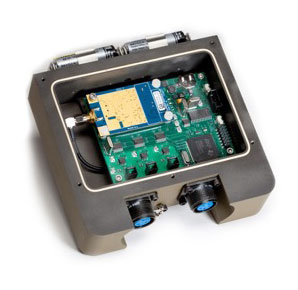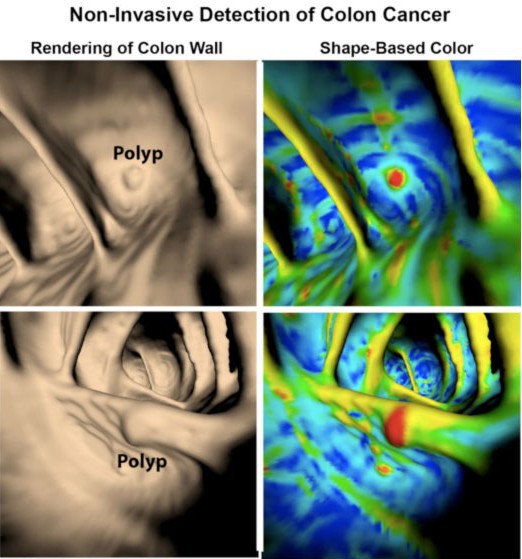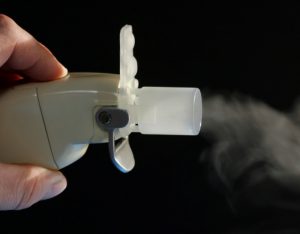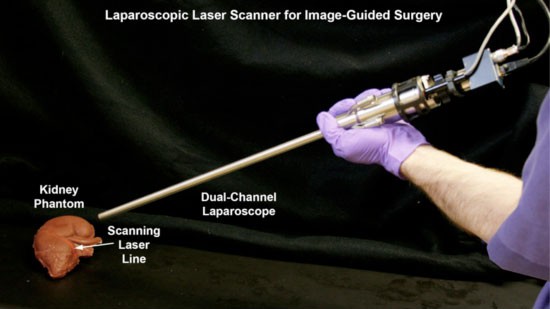Creare works across a broad spectrum of biomedical applications, building on core capabilities in precision fabrication, software development, signal and image processing, sensor design, control systems, and thermal/fluid technology. We frequently collaborate with leading clinicians at nearby Dartmouth-Hitchcock Medical Center, a 400-bed teaching and research hospital, and at institutions such as Harvard Medical School, Johns Hopkins University, Memorial Sloan-Kettering Cancer Center, and Duke University. Prototype devices are typically built and tested in our own laboratories and are validated in a clinical environment when appropriate.
Examples of past or ongoing development efforts include:
- Innovative signal processing algorithms and software for cardiac electrophysiology.
- Image processing methods for early detection of disease and monitoring of therapy.
- Probes for surgical treatment of cancer.
- Robotic control software for telesurgery.
- Portable cryogenic systems for producing medical grade oxygen.

Creare seismic sensor module.
Development and implementation of novel signal processing algorithms is a key part of many projects at Creare. The algorithms are typically implemented in Python or MATLAB® depending on application. One of these projects involved development of a buried seismic sensor system designed to detect people based on the seismic signature of their footsteps. This is a challenging problem as the seismic signals are often buried in noise from automobiles or machinery in urban areas. In rural areas it is necessary to differentiate signals from people from those of wildlife, wind, and rain. We developed and tested a number of algorithms for background noise estimation, signal filtering, and detection.

CT-based images of the colon wall processed to aid identification of polyps.
Recent advances in medical imaging technology are revolutionizing many areas of medicine. One good example is in cancer screening. Computed tomographic (CT) imaging of the colon can replace invasive tests required to detect polyps that often lead to colorectal cancer. Creare developed tools to assist radiologists in reviewing the CT scans to find precancerous polyps.
We also investigated the use of non-invasive imaging methods that have the potential to detect cancer in its earliest stages. One of these methods involves the use of Magnetic Resonance Imaging (MRI) to measure perfusion in different parts of the body. MRI imaging can be used to measure the uptake of contrast agent in both normal and cancerous tissue as a means to quantify perfusion and differentiate between healthy tissue and tumors. This form of contrast-enhanced MRI has emerged as a powerful method for characterizing tumors and determining treatment efficacy in other forms of cancer (most notably brain and prostate). However, image artifacts due to respiratory motion have precluded its use in the abdomen. Creare developed automated image processing methods that greatly attenuate respiratory motion to overcome this limitation.

Compact reusable nebulizer for respiratory administration of atropine to treat nerve agent casualties.
Creare develops novel devices for the delivery of vaccines, drugs, and other pharmaceutical products. We have developed dry powder inhalers, nebulizers and prefilled injectors. To support this work, Creare uses test methods and equipment for measurement of aerosol output, particle size (via laser diffraction), and regional deposition (using respiratory phantoms and fluorescent aerosols), and we employ computer-aided engineering tools (CFD and FEA). We are also active in the area of mobile health, and we have developed a smartphone-based application for monitoring drug adherence.
Below are further details on some of our projects:
- Creare’s nebulizer technology centers on a disposable drug cartridge (DDC), a patented approach that contains all of the wetted components of the aerosol generator in a low-cost disposable cartridge.
- Creare has developed prototype nebulizers and dry powder devices for administration of vaccines. Creare has also developed a small DDC-based nebulizer for treating nerve agent exposures.
- Creare is developing a novel miniaturized autoinjector—based on our patented storage and reconstitution technology–that automatically mixes two or more pre-filled components immediately prior to injection.
- Our smartphone-based adherence monitoring system obtains time and dosage information in near real-time during clinical trials. We can pair this smartphone application with a mobile fluorometer to confirm adherence by testing for a fluorescing biomarker in urine.
Creare develops technologies to improve the hearing protection available to the military and industry. Hearing-related illnesses are the most costly Department of Defense disability (with direct payments in excess of one billion dollars annually). Creare’s hearing protection design philosophy follows the engineer’s mantra “keep it simple,” emphasizing fully-passive solutions. To support our hearing protection work, Creare has developed a number of biofidelic ear and head simulators that model both the air and bone-conducted acoustic pathways; we have delivered a number of these to military hearing researchers.
Other examples of our work include:
- Aircraft maintenance crews, particularly those on aircraft carrier flight decks, work in a fast-paced, dangerous, and extremely noisy environment (over 140 dBA SPL). Creare designed a helmet-integrated hearing protection system for the next-generation flight deck cranial (FDC). The completely passive cranial maximizes noise attenuation by blocking bone-conducted sound and boasts a NRR (Noise Reduction Rating) of over 40 dB when worn with earplugs.
- Upgrading the hearing protection of existing helmet systems offers a cost-effective way of alleviating the noise-exposure challenges of tomorrow’s louder aircraft platforms. Creare has designed a modular upgrade for the Gentex HGU-84/P rotary-wing aircrew helmet that offers 7.6 dB more protection over the stock system, enabling longer mission durations with reduced risk of hearing disability.
- Creare used its hearing protection expertise to design a stand-alone hearing assessment system for use outside a traditional sound booth. This allows for testing in relatively remote areas, expanding access to hearing health care.
Creare develops technologies to enable hearing evaluation in challenging environments and to improve the sensitivity of the assessment for specific applications such as noise-induced hearing loss and functional hearing (fitness for duty). Our hardware includes novel designs for in-ear probes that measure the response of the ear to acoustic stimuli, as well as advanced digital electronics to enhance low-noise processing of the recorded sounds in the ear canal. Creare works with audiologists, psychoacousticians, and other hearing researchers to support the development of new tests of hearing and protocols targeting specific auditory functions such as central auditory processing, the middle ear, and speech intelligibility in challenging ambient environments. A number of our hearing assessment systems have been designed for seamless integration with our mobile health (add link) platforms.
- As part of an NIH-funded study to investigate the effects and treatment of HIV/AIDS on patients’ hearing, several of Creare’s hearing assessment systems have seen continuous use at a clinic in Dar es Salaam, Tanzania, for the evaluation of several hundred human subjects. The deployed system assesses peripheral, central, and overall auditory function.
- Our innovative noise attenuation, wireless, audiometric headset is designed to increase access to hearing healthcare by allowing accurate hearing testing outside of a sound booth, Currently in transition, Edare is manufacturing the first 100 headsets to be delivered to some of our customers.
- Creare‘s low cost, wireless and mobile Distortion Product Otoacoustic Emissions probe promises to enable widespread hearing screening in infants and children, as well as other difficult to test populations, in low resource and remote areas. The probe is easy to insert into the ear, and pairs with an intuitive application on a smartphone or tablet, enabling non-specialized users, like midwives and nurses, to easily test an infant’s hearing.
- Creare’s Hearing Assessment (CHA) system provides researchers with the ability to conduct diverse hearing tests using one system only, with one database which can be hosted locally or on the cloud. As many as 50 systems have been delivered to researchers across the World, and they are now in use on multiple continents, including North and Central America, Asia and Africa.
Researchers Develop Operationally Specific Auditory Tests to Assess Fit-for-Duty Hearing Performance in Service Members — Dr. Odile Clavier of Creare LLC and researchers within the Department of Defense have developed novel tools to measure more operationally-specific hearing ability. The tests are administered on hand-held mobile tablets that connect wirelessly to the Creare-developed noise attenuating audiometric headset. This makes it possible to perform the tests outside the clinic, even in operational environments.

Laparoscopic laser scanner developed by Creare for use in minimally invasive resection of kidney tumors.
To aid surgeons in their life-saving work, Creare invents new medical devices that can reduce morbidity and mortality and enhance outcomes for these procedures. Our work builds on our expertise in precision fabrication, optics, and real-time image processing.
In one example, Creare developed a system to enhance visualization of important anatomic features (major vessels and tumors) during the minimally invasive surgical procedures. Although minimally invasive surgery is enjoying rapid growth due to lower costs and reduced postoperative pain, it remains technically demanding and complicated by the fact that the surgeon has limited visibility into the surgical site and no tactile feedback. The Creare system incorporates a laser scanning capability into the surgical laparoscope to provide highly detailed, three-dimensional measurements of organ shape and position in real-time during surgery. The intraoperative measurements of organ position and shape can then be combined with information obtained from preoperative magnetic resonance or computed tomographic imaging to allow the surgeon to determine the position of key anatomic features even though they may not be directly visible during the procedure. The technology developed for this application serves as the basis for Creare’s precision metrology systems.